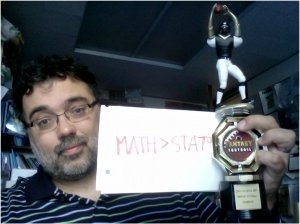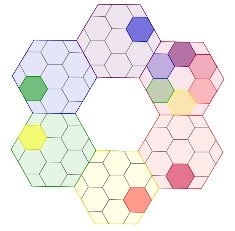Blogging and Tweeting and Wikis and YouTube in Math Classes? You Bet!

Grand Valley Mathematics Department professor Dr. John Golden uses all of these types of technology in his math classes for future teachers. He began, about two years ago, by starting a blog of his own. He had things he wanted to share and had been reading some excellent blogs by Dan Meyer and Kate Nowak. John explains, “I knew I should be doing reflective writing somehow ... finally it all added up to a tipping point. I think I originally thought of it mostly as a way to record links to other worthwhile resources for my students.” It has developed into much, much more.
On his blog, John posts regularly about his thinking related to mathematics education, keeps a list of other blogs people may be interested in, and has a variety of resources related to the free computer software program GeoGebra. On a recent visit to his blog, there were users from Michigan, Pennsylvania, England, Malaysia, Portugal, the Philippines, and India who had visited the site in the two hours prior to my visit!
But, blogging is not all the John has been doing in terms of technology related to math education. He has gotten his students involved as well. John often co-teaches Ed 307. This course is a 1-credit seminar for secondary math majors who are currently teacher assisting. These teacher assistants (TA’s) spend every morning working in high school mathematics classrooms. One of their biggest wishes, according to John, is a way to develop a community of learners outside of the classroom since they only meet as a class once a week.
After talking to a colleague at Muskegon Community College who had successfully used Twitter in an on-line calculus course, John and GVSU colleague Dr. Rebecca Walker began incorporating tweeting into their Fall 2010 semester teacher assisting seminar. The use of tweeting gave John and Rebecca daily information on what was going on in the teacher assistants’ classrooms. John notes, “those who engage with this (tweeting) seem to find that it enhances their teaching and professional practice.”
Jacob Dunklee, a student who had tweeted and blogged as a part of the Fall 2011 teacher assistants and still does so, is an enthusiastic supporter of both mediums. He explains, “Through twitter TA's are able to make friends with other professionals and in times of need (for worksheets, lessons, ideas, etc) the twitter community responds usually within a half hour with more ideas, lessons, worksheets than one could use.
But twitter has its limitations of 140 characters per post. This is where blogging picks up. With blogs, TA's can go into detail about what is troubling them and what they have done so far to try to fix this issue. They are not limited to a certain number of characters. Once you have written your blog you can go back to twitter and post that you have written it and again the twitter community responds with insight on how to help you become the best possible teacher imaginable. I am now friends with over 300 mathematicians around the world, ranging from California to the United Kingdom. Without their help I would have no where near the ideas that I have today on what truly makes an excellent teacher.”

John is continuing to use tweeting with his Winter 2011 semester teacher assistants as well as having students write a weekly blog. Carlee Hollenbeck, a current teacher assistant has found blogging and tweeting to be a valuable way to learn. She states, “John Golden has inspired me to find ways to connect with other educational professionals through nontraditional forms of technology and has ultimately altered my opinion of these tools. Prior to my experiences with Twitter and blogging, I had limited resources to find support in a community outside of Grand Valley. John Golden has inspired me to stay connected and up to date with the current issues within the educational field. He truly has enriched my life and provided me with a variety of tools that will be of tremendous help when becoming a young educator.”
Sarah Smith, another current TA, continues, “I have been asked to blog in a few other education courses in past semesters, but all they wanted from me was to answer specific questions, so at first I was not looking forward to blogging in this course. Quickly, I realized that I was able to blog about anything as long as I was reflecting upon my experiences in the classroom and how they relate to what we were discussing in class. I don’t particularly enjoy writing blog posts because I never know what to write about. However, once I’ve finished a post I’m happy I did it because I feel like I resolved a dilemma or have a more clear picture of who I want to be as a teacher. I think blogging this semester has really helped me organize my thoughts about the many aspects of teaching. Also, it is a great tool for educators at any level.”
In other mathematics education courses, John is also exploring how to use technology to enhance student learning. The students in his fall 2010 Geometry for Middle School Teachers course (MTH 322) created a YouTube video and his Winter 2011 Mathematics Activities for Secondary Teachers (Math 229) students are creating a Wiki about functions. John is hopeful that the Wiki will, over time, develop into a valuable resource for teachers
John has also created a glog (a graphics-based blog—a sort of interactive poster) that summarizes his use of technology in education. This glog highlights a variety of technology including John’s use of Prezi (a non-linear on-line presentation tool), Google docs, and Dropbox (a service that allows users to easily share and edit files via cloud computing).
With all of this interesting technology to explore, John certainly stays busy. He has found that a big challenge of his own when tweeting or blogging is to avoid the potential for getting overwhelmed by all of the available resources. He says, “there are so many people worth talking to that you have to be careful about going down the rabbit hole.” Why don’t you join John in the fun of exploring great sites. Start by checking out his blog at mathhombre.blogspot.com.

